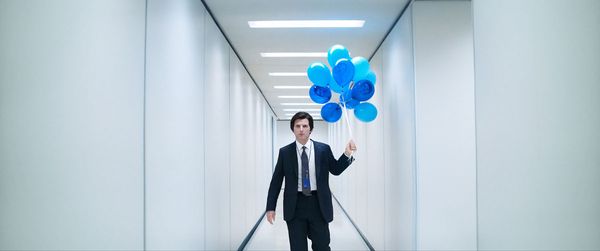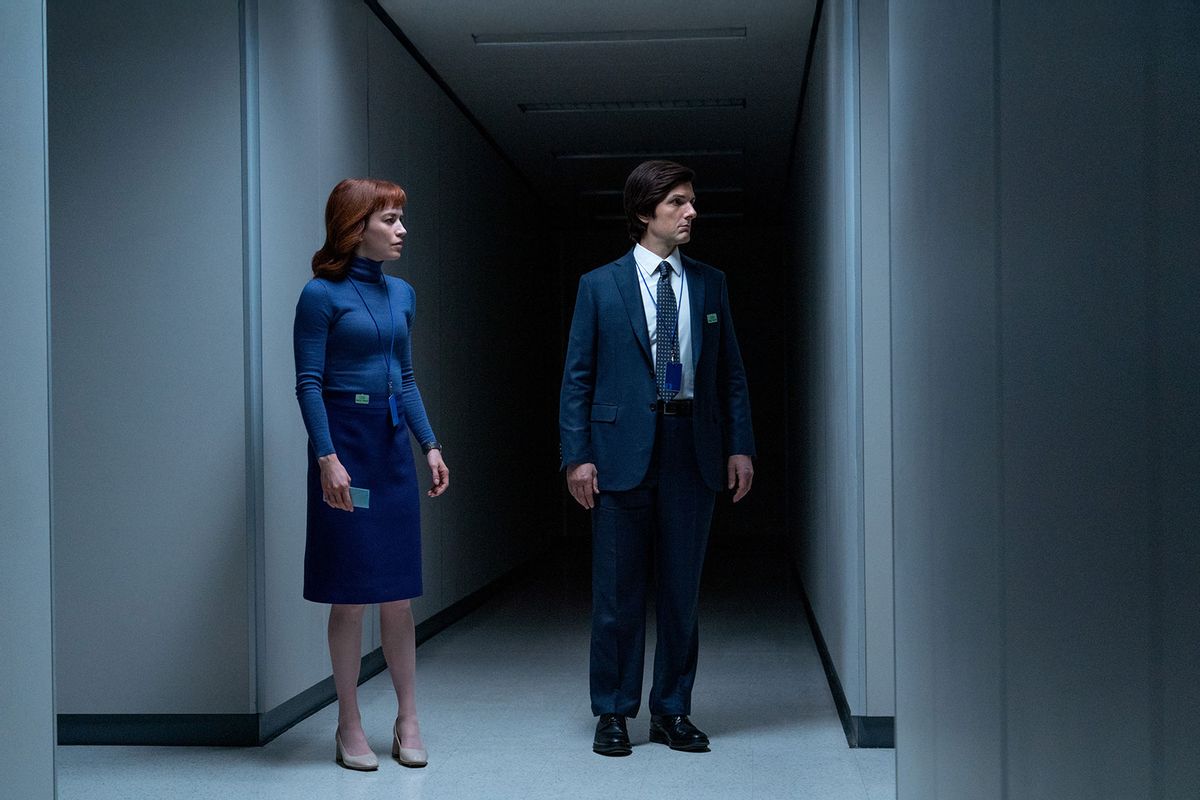“Severance” drops us back into the never-ending workday of Adam Scott’s Mark Scout, dashing frantically through Lumon Industries’ blank hallways, as if lost.
He shouldn’t be. The work version of Mark S. used to be comfortable with daily patterns and efficiently sensing how number groupings go together. He was fine living for his job even if he didn’t know much about the company he works for, or what he's doing. He’s the contented “Innie” to the miserable “Outie” version of himself, the one so paralyzed by his wife’s death that he chose to surgically divorce his work life from the mess of his personal time.
Except . . . at the end of Season 1, Mark and two of his Macrodata Refinement co-workers on the Severed floor, Helly R. (Britt Lower) and Irving B. (John Turturro) found a way for their Innies’ consciousnesses to escape into the bodies of their Outies briefly, allowing chaos to invade the land of order.
In the meantime, somebody moved Mark’s cheese.
Between the first and second seasons, "Severance" lost none of its mind-bending electricity.
Maybe that’s not the reference its creator Dan Erickson and the show's main director and executive producer Ben Stiller meant to ping in our brains. Not everyone was subjected to late ‘90s motivational business propaganda preaching the management of expectations and flexibility to weather mission creep and downsizing. But we all recognize a rat race when we see one.
Mark runs at full speed, stopping only at corners to decide whether to lurch left or right, literalizing that glum complaint: Only Mark has it so much worse than we do. Beyond impressing us with Scott’s enviable cardiovascular fitness, this kinetic reintroduction to “Severance” emphasizes the endless cycle of misery dooming Mark and his co-workers to be permanent maze runners.
When he finally finds what he’s looking for, the cheese is . . . funky. It’s off. His supervisor Mr. Milchick (Trammel Tillman) serves it to him with a blinding, forced smile and a greeting of, “Welcome back, Mark S. It’s been a minute.”
There are workplace dramas that feel like work, and there is this show about cubicle life — one frontloaded with unease, odd humor, and the suspicion that something about the reality they’re presenting is very wrong. It has been a minute – for Mark, many of them, although the shift between Outie life and the Innie elevator takes mere moments, thanks to the chip installed in Mark's brain. But in that time between the first and second seasons, "Severance" lost none of its mind-bending electricity.
Season 2 comes to us nearly three years after the show’s debut and days before a new presidential administration promises to accelerate America’s slide into a technocratic oligarchy. And if you’ve worked for any of the men cozying up to the new boss, you’ll recognize the undertones of organizational zealotry in “Severance.” You’ll understand preaching efficiency is a smokescreen for squeezing more blood and sweat out of working people.
 Adam Scott in "Severance" (Apple TV+)
Adam Scott in "Severance" (Apple TV+)
This show, though, transforms familiar drudgery into fantasy. Lumon’s Severed floor is a surreal corporate sideshow whose morale exercises are only a few shades off from the forced displays of joy we’re expected to attend with enthusiasm.
Instead of endless sheet cakes and pizza, Helly, Irving, Mark and Dylan G. (Zach Cherry) are rewarded with fruit, waffles, and dance breaks. When you think about it, does one really make more sense than the other? You’ll probably put that question aside for now, since the bigger one is why there’s a kid, Miss Huang (Sarah Bock), working on the Severed floor.
The second season broadens our dim glimpses of Kier, the town supported by Lumon, to hook into the ways corporations impose their culture on entire places, altering the way society functions from how we treat each other to the way we’re expected to live.
We need your help to stay independent
If you haven’t seen the first season, stop reading and get to it. It’s as likely you’ve forgotten what happened, which is easily rectified by watching the Season 1 finale. In short, Helly R. found out she’s no ordinary office drone, but the heir to the company, Helena Eagan, unwittingly playing “Undercover Boss.” Irving tries to reunite with his lover Burt Goodman (Christopher Walken) on the outside, only to find Burt happily partnered with someone else.
There’s more to examine in the way “Severance” shifts our focus away from the practical machinery behind Lumon’s endgame, whatever that may be.
Mark, poor Mark, realizes the company’s wellness therapist Ms. Casey (Dichen Lachman) is an Innie to – the severed version of his very much alive wife Gemma. His alarming discovery is the hub around which an assortment of related mysteries swirl, including what and who characters like Patricia Arquette’s Harmony Cobel are to Lumon and the Severed floor’s workers.
The conscious design of “Severance” augments every layer of the show. From its florid dialogue and thrilling subtleties in each actor’s performance to its sets, props, and the further development of Lumon’s bizarre mythology, it’s constantly refreshing the viewer’s delight in being confused. How people speak and the implied meaning of what they say takes on increasing meaning in these 10 new episodes Apple TV+ has warned critics not to talk about with much specificity.
The guest star roster expands this season, looping in Gwendoline Christie, John Noble, Merritt Wever and Alia Shawkat, among others, blending them into the show’s hallucinatory starkness without drawing us out of the story. The scripts also bump up Tillman’s screentime, making his un-severed experience at Lumon more central.
Want a daily wrap-up of all the news and commentary Salon has to offer? Subscribe to our morning newsletter, Crash Course.
There’s more to examine in the way “Severance” shifts our focus away from the practical machinery behind Lumon’s endgame, whatever that may be, toward more phenomenological considerations. That is, MDR is pushed to weigh the meaning and value of their lived experience against the half of their lives being kept from them.
Helly R. has feelings about Helena; Innie Mark knows nothing about his Outie’s life with Gemma or the ocean of love he has for her. In the first season, Milchick tells Dylan he has a family, which changes his view of work and inspires Cherry to shift his performance into a higher gear.
All of it translates the outsized role corporations can impose on our waking hours into sinister folly while asking us to ponder whether half a life is worth living regardless of the perks.
“Severance” amplifies its intrigue without falling into the second-season trap of making key enigmas inscrutable or boring, a trap too many puzzle-box shows tumble into when challenged to top their triumphant first seasons. Solutions to a few of the show’s paramount riddles emerge in the course of these 10 hours, accompanied by the classic series-extending gambit of presenting more questions.
Some may never be answered; at the moment I don’t need or even want to know why all the cars are old and weathered and the desktop terminals obsolete in a place where cell phones exist, and I’m fine with that. It’s better to know this labyrinth has corners we’ve yet to encounter and the energy to maintain its momentum although, unlike Mark S., you may be content to take your time to arrive at wherever the writers are leading us.
Season 2 of "Severance" streams weekly starting Friday, Jan. 17 on Apple TV+.



Shares